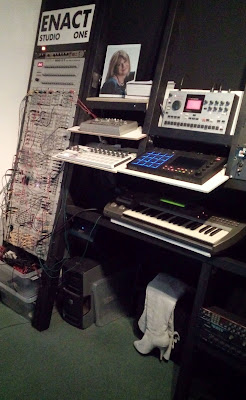Doepfer announced the new modules that will be on display there... with some very exciting new toys.
Some of the new products were already presented as prototypes at NAMM and are now available (e.g. the voltage controller performance mixer series A-135-4). But they will also show some new gear in Berlin (e.g. the quad VCO A-111-4, the micro keyboard A-173-1/2, the miniature stereo mixer A-138s and the low cost versions of the monster cases).
 |
| A-111-4 Quad VCO |
After all the A-111-4 is very similar to four A-111-3 with built in output mixers for the three waveforms and a common control unit for all VCOs. Controls, inputs and outputs (individual for each and common for all VCOs): 1V/Octave CV input Octave switch (+1/0/-1 octave) Tune control (range internally adjustable by jumpers: 2 semitones / 1 octave / 4 octaves) Modulation CV input (common unit is fixed to FM) Modulation destination FM or PWM (only for the individual VCOs) Modulation intensity Triangle output Sawtooth output Rectangle output Sync input (only for the individual VCOs, internally selectable hard or soft sync, CEM3340 hard sync type)
Typical applications: fat sounding monophonic VCO with the possibility to adjust intervals paraphonic patches (all four VCOs processed by one VCF/VCA) full polyphonic patches in combination with the polyphonic CV interface A-190-5 Date of Delivery: summer 2017 Price: ~ Euro 400.00
 |
| A-138s Stereo Mixer |
 |
| A-173-1/173-2 Micro Keyboard |
1V/Octave CV signal and up to 15 manually controlled gate/trigger signals.
Typical applications are the transposition of a sequence by means of the CV output (without the need of an external keyboard and CV interface) and the manual generation of gate/trigger signals for start, stop, envelope generator triggering and other trigger tasks. A-173-1 is the transmitter module and is made of a 1 ½ octaves micro keyboard and an octave switch. A-173-2 is the receiver module and generates several gate/trigger signals and a 1V/Oct. CV signal.
The upper section of the module is used for the gates/triggers which are controlled by the corresponding buttons of the A-173-1.
Each output can be programmed as gate (pressing/releasing the corresponding key turns the gate on/off) or toggle (pressing the corresponding key changes the state) or trigger (pressing the corresponding key generates a short trigger signal).
The state of each output is displayed by an LED. The lower section of the module is used the generate a 1V/Oct. CV signal and gate signal in the usual way.
 |
| A-180-9 Multicore Prototype |
That way e.g. start/stop or other triggers become independent from the CV section. The modules communicate via standard midi note on/off messages and are connected internally by means of a 2-wire cable. That way the modules can be mounted at different positions within the case. Date of Delivery: summer 2017 Price: ~ Euro 180.00 (both modules)
Also a prototype of a new Multicore was on display, but the module has been updated, so the info here is old... Find info about the definitive 2018 version HERE
A-180-9 is another simple but useful tool. It is used to connect up to 12 signals between two different
For operation two of the modules (male and female version) and a Sub-D cable with the required length are required.
Because only male/female Sub-D cables are common on the market also one male and one female version of the module is required for the connection.cases by means of one standard Sub-D cable only. That way it's possible to pre-patch e.g. two (monster) cases and connect all signals, that are required in both cases (e.g. clock, start/stop, master CV) by one cable only instead of 12 individual patches. The module is fully passive (no power supply required) and simply wires the 12 sockets to 12 pins of the Sub-D connector.
Source: Doepfer.de
Source: www.SuperBooth.com






